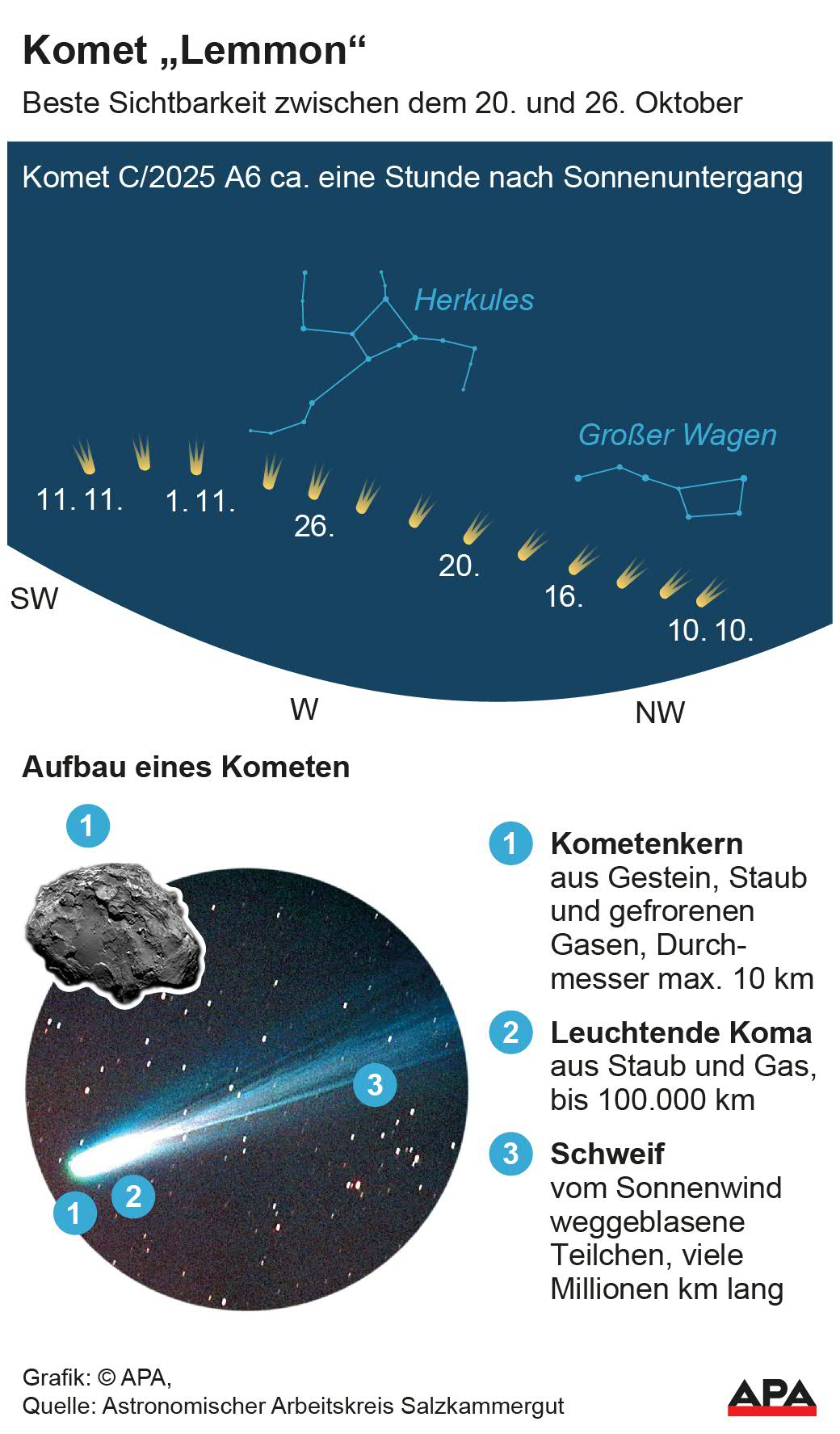Comet "Lemmon" Approaches Earth: When to See It with the Naked Eye

After the comet "C/2023 A3 Tsuchinshan-Atlas" offered good visibility almost exactly a year ago, another bright comet is now announced: The comet C/2025 A6 (Lemmon), discovered only at the beginning of this year, can be seen from mid-October as a noticeable object with simple telescopes, and with low light pollution, that is, away from urban centers, even faintly with the naked eye, explained comet specialist Michael Jäger to the APA.
Comet "Lemmon" surprisingly bright celestial body
The comet C/2025 A6 (Lemmon) was discovered in images from January 3 of this year by the Mount Lemmon Survey (USA). It approaches the sun on an extremely long-period, elliptical orbit and reaches its closest point to the sun (perihelion) on November 8 at a distance of 79 million kilometers, which corresponds to half the distance of the Earth from the sun, according to Alexander Pikhard from the Vienna Working Group for Astronomy (WAA). It has its closest distance to Earth on October 21 at around 90 million kilometers.

"Lemmon" had a brightness outburst in the summer. That it is developing so well is "unexpected, as this comet was initially estimated to be much weaker in the original forecasts. However, it is not the first time that the brightness development of a long-period comet is very dynamic," emphasized Jäger, chairman of the Astronomical Center Martinsberg (AZM) in the Waldviertel (Lower Austria).
At the beginning of October, the comet reached the 6th magnitude class - a measure of apparent brightness - and is thus on the verge of being visible to the naked eye - at least under a dark mountain sky. "Current brightness estimates in moonlight show that the upward trend continues and we can expect an object of the 4th magnitude class in a few days," said Jäger. He names the period between October 20 and 26 as the best phase, when the comet stands about 20 degrees high in the sky at the end of twilight and should then be as bright as the 3rd magnitude class.
Comet "Swan" only visible with a telescope
According to experts, this brightness should be enough to see the comet with the naked eye in a good rural sky with low light pollution, but it would be more reasonable to observe it with good binoculars. According to the Astronomical Working Group Salzkammergut (AAS), "Lemmon" is located below the constellation of the Big Dipper, in the evening from 7:30 PM deep in the northwest or even better, as it is higher above the horizon, between 4:00 and 5:00 AM in the northeast. At the end of October, the comet then moves through the constellation Serpens in the west. After October 26, the moonlight increasingly interferes, and the comet also slowly sinks towards the horizon. After November 10, visibility ends for us, according to Jäger.
October even offers a second comet: C/2025 R2 (Swan) is "rather something for specialists," according to the AZM chairman. The comet moves low in the evening sky through the summer Milky Way until mid-October and is only visible through a telescope. As it moves further away from the sun, it appears increasingly diffuse.
Comparison with Dirty Snowballs
Comets are considered remnants of the formation of our solar system around 4.6 billion years ago. They consist of a mixture of ice, dust, and rock and are therefore compared to dirty snowballs. The ice contains not only frozen water but also, among other things, frozen carbon dioxide, methane, and ammonia. Many comets move in highly elliptical orbits through the solar system: They emerge from the outskirts of the solar system and come very close to the sun, where they thaw and the often spectacular tail is formed.
Thawing creates a large cloud of gas and dust around the small comet nucleus, the so-called coma. The "solar wind," a constant stream of particles from the sun, blows the thawed gas-dust mixture away from the comet and thus forms the tail, which always points away from the sun.
(APA/Red)
This article has been automatically translated, read the original article here.
Du hast einen Hinweis für uns? Oder einen Insider-Tipp, was bei dir in der Gegend gerade passiert? Dann melde dich bei uns, damit wir darüber berichten können.
Wir gehen allen Hinweisen nach, die wir erhalten. Und damit wir schon einen Vorgeschmack und einen guten Überblick bekommen, freuen wir uns über Fotos, Videos oder Texte. Einfach das Formular unten ausfüllen und schon landet dein Tipp bei uns in der Redaktion.
Alternativ kannst du uns direkt über WhatsApp kontaktieren: Zum WhatsApp Chat
Herzlichen Dank für deine Zusendung.








